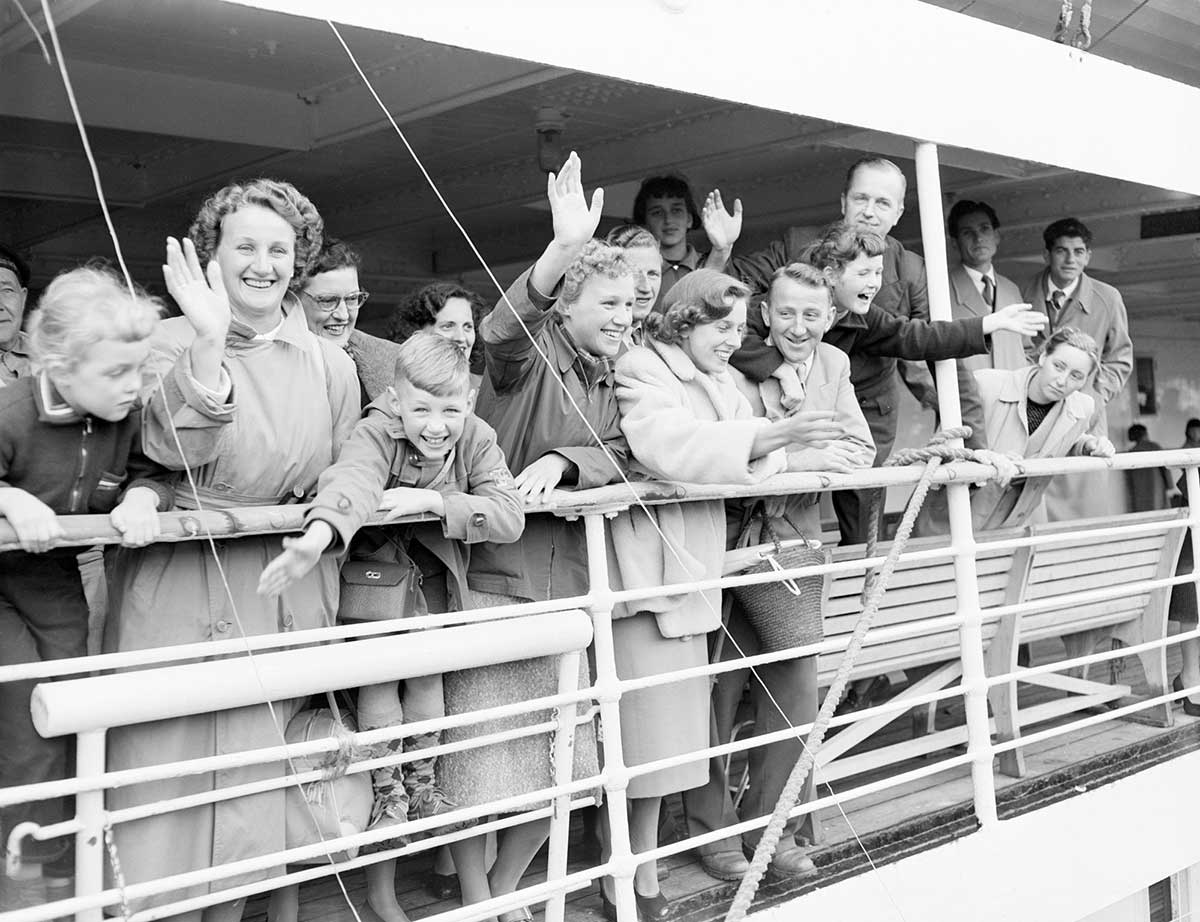 a ship arriving in Australia." />
a ship arriving in Australia." /> a ship arriving in Australia." />
a ship arriving in Australia." />
The passage of the Nationality and Citizenship Act 1948 marked the first time the term ‘Australian citizen’ had been used in any legislation, including the Constitution.
While the Act had symbolic importance, it was driven more by pragmatism than a desire to enshrine a distinct national identity. The Act, though much amended, still provides the legislative framework for how a person becomes an Australian citizen.
Immigration Minister Arthur Calwell, 1948:
It will symbolise not only our own pride in Australia, but also our willingness to offer a share in our future to the new Australians we are seeking in such vast numbers … They will no longer need to strive towards an intangible goal, but can aspire to the honour of Australian citizenship . We shall try to teach the children that they are fortunate to be British, and even more fortunate to be Australian
Until 1949 there was no such thing as an Australian citizen. Before that, anyone born or naturalised (made a citizen) in Australia was a British subject. People travelling overseas were issued with British passports.
Unlike the United States Constitution, the Australian Constitution has little to say on citizenship beyond stating that to stand for parliament you cannot have dual nationality. There is no mention of ‘Australian citizenship’.
This is because at the time of Federation, and until at least the Second World War, most Australians identified themselves as British.
However, from the 1940s onwards, the disintegration of the British Empire and the increase of non-British migration to Australia led the federal government to develop the concept of Australian citizenship.

The Canadian government in 1946 was the first in the British Commonwealth to implement its own citizenship act. This undermined the uniformity of British subject status across the Commonwealth and led to the British Commonwealth Conference on Nationality and Citizenship in London from 3 February 1947.
At the conference it was agreed by the self-governing nations of the Commonwealth that each nation would be free to define its own citizenship.
This led to the passing of the British Nationality Act 1948, the British Nationality and New Zealand Citizenship Act 1948, the South African Citizenship Act 1949, and in Australia, the Nationality and Citizenship Act 1948.
The citizenship legislation was introduced to the House of Representatives by Arthur Calwell, Australia’s first immigration minister. Calwell was at pains to point out that Australians would remain British subjects while also becoming Australian citizens.
Calwell was the architect of the Chifley Government’s postwar immigration drive which actively sought migrants from non-British backgrounds. The principle underpinning the Act was ‘assimilation’. Immigrants were expected to assimilate into Australian society as much as possible, and Australian citizenship was offered as an incentive to do so.
There were those who felt the Act didn’t go far enough. Cross-bencher and former Labor Premier of New South Wales Jack Lang asserted that the Act did not explain what being an Australian citizen meant in terms of rights and privileges.
Meanwhile, the Liberal-Country Party coalition was outraged by the legislation, calling it ‘a sinister plot to liquidate the Empire’.
Nonetheless, the Nationality and Citizenship Act 1948 was passed and came into effect on Australia Day, 26 January 1949.
The Act created Australian citizenship and the conditions by which it could be acquired. The main provisions of the Act were that:
However, under the Act, British subjects who wished to become Australian citizens could do so quickly and easily, whereas ‘aliens’, that is foreigners resident in Australia who were not British subjects, found it a lot harder.
The Department of Immigration saw the take up of Australian citizenship and the success of its migration policies as interlinked, and monitored naturalisation rates.
Relatively few migrants applied for citizenship, partly because it conferred too few benefits, such as increased employment opportunities or government benefits, and partly because it was a long and complicated process if you weren’t already a British subject.
From 1950 the government organised Australian citizenship conventions and the Good Neighbour Movement to help promote citizenship and encourage new citizens to assimilate by providing formal language and culture classes, written resources and advice bureaus.
Aboriginal and Torres Strait Islander people gained little from the Act. They were not specifically excluded from the legislation and so were, technically, Australian citizens. However, they were still unable to vote – one of the key privileges of citizenship.
It wasn’t until 1962 that the Menzies government amended the Commonwealth Electoral Act 1918 to enable all Indigenous Australians to enrol to vote in federal elections.
Since it was passed, the Nationality and Citizenship Act 1948 has been amended more than 30 times as attitudes towards immigration have changed. It was renamed the Australian Citizenship Act in 1973.
From 1973 federal governments have gradually removed the favoured status accorded to British subjects and extended Australian citizenship to people on a non-discriminatory basis.
In 1984 the law was altered so that Australian citizens would no longer be considered British subjects, and British citizens arriving in Australia would no longer be able to vote in elections until they had become Australian citizens.
Changes to the legislation in 2007 introduced a citizenship test and increased the residence requirement from two to four years. These changes represented a departure from, and possibly an end to, the trend of making citizenship easier to acquire.